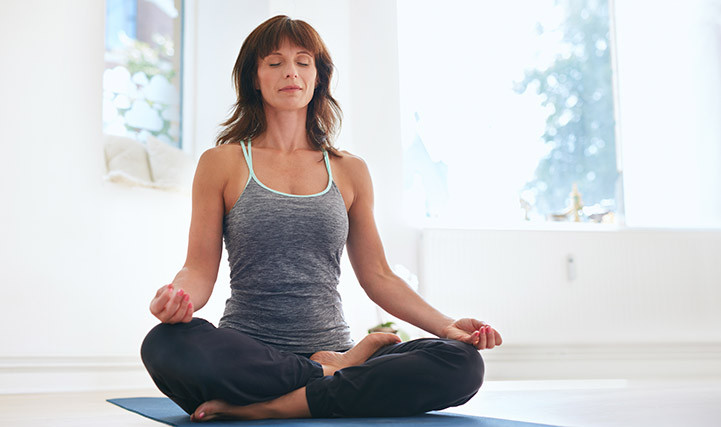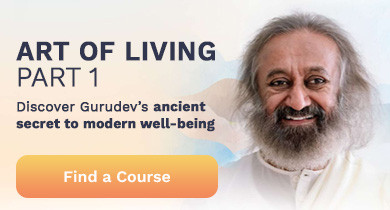
On average, we take 20,000 breaths every single day. Breathing is one of the most important processes that occur in our body, and yet, most of us spend very little time thinking about it. After all, it’s one of the processes our autonomic nervous system takes care of for us.
But what would happen if we spent time actively focused on our breathing? Would we start to see added benefits to our health?
This article will teach you all about conscious breathing, including the benefits and how to do it!
Topics covered:
- What is conscious breathing?
- What are the benefits of conscious breathing?
- How to practice conscious breathing
- Add conscious breathing to your next Art of Living course
What is conscious breathing?
Although we don’t have to remember to breathe (as mentioned above), taking the time to intentionally inhale and exhale is beneficial to our health. This is called conscious breathing, and it’s been around for thousands of years. In yoga, it’s called Pranayama and refers to accessing the life force (Prana) that is your breath.
Experts have discovered how valuable conscious breathing techniques can be for our well-being. These effects are especially evident in our central nervous system, leading to better emotional regulation and psychological well-being.
What are the benefits of conscious breathing?

Conscious breathing offers a number of benefits, but one of the most impressive is its ability to relax your nervous system. You’ve likely noticed how your breath gets more shallow when you are stressed or panicking, which can even cause hyperventilation. This is the result of the sympathetic nervous system (SNS) activating your body’s fight-or-flight response.
Although this response can help us survive in times of danger, it can be detrimental to our health when prolonged, especially when there is no physical danger. Getting stuck in a state of fight or flight can lead to anxiety and depression or physical illness.
That’s why it’s crucial to take the time to pay attention to your breath, especially in times of stress. Doing so calms down your nervous system, allowing the parasympathetic nervous system (PNS) to regain control and activate normal processes in your body. As a result, you experience less anxiety and have more control over your emotions. These healthy processes are only possible when your brain feels you are safe to rest and digest, clear of any danger.
Of course, a relaxed nervous system isn’t the only benefit of conscious breathing. Here are some other reasons you should make this practice part of your daily routine.
- Better mood: There is a strong connection between our breathing, emotions, and mood. When you feel calm, you are able to think clearly and be more mindful. That doesn’t mean you won’t ever experience unhappy emotions, but you are more aware of them. This awareness allows you to respond to them in a way that is compassionate and helpful.
- Increased energy: Conscious breathing supplies your body with more oxygen, which is essential for your cells and tissues. The extra oxygen can lead to an energized feeling that leaves you more alert.
- Relieves tension: When we’re stressed, we accumulate a lot of tension in our muscles, and one of the reasons is that we are taking too shallow breaths to release the stress from our bodies. If this becomes a habit, you may live with constant muscle stiffness and tension in your upper body. One study found that deep and slow breathing can provide relief, reducing tension and even improving heart rate variability.
- Regulates blood pressure: Controlled breathing is one of the techniques you can use to potentially lower your blood pressure. Research suggests that even 10 minutes a day of breathing exercises is effective enough to see results. These findings show just how important mindful breathing is for your cardiovascular health since it is directly linked to your blood pressure.
- Improved sleep quality: Deep breathing can help relax your body and prepare you for sleep. This has to do with releasing the stress and worries of the day, which lets you fall into a deeper sleep without tossing and turning. Practicing it for 15 minutes before bed can improve your sleep quality.
- Better digestion: If you experience poor gastrointestinal health, your breathing practice can benefit your physical health in a surprising way — reducing indigestion. The responses triggered in your nervous system during diaphragmatic breathing help your body relax, which is the state in which it digests most optimally.
- Better lung function: Diaphragmatic breathing is also great for your respiratory system. If you have asthma or other lung issues, conscious breathing can strengthen your lungs and reduce your symptoms.
How to practice conscious breathing with meditation

Conscious breathing is a great way to prepare for meditation. It helps you be more aware of the present moment, putting you into the right frame of mind for your practice. The relaxation it induces also makes it easier to slip into a meditative state.
Of course, you don’t have to limit conscious breathing to a certain moment. You can practice it whenever you feel the need to relax, such as before bed. Tack it on to the end of your meditation and let it serve as a transition.
Another option is to use yogic breathing while stretching or center yourself before your yoga practice. That’s the great thing about conscious breathing — it’s a very flexible form of self-care!
Here’s how to do it.
1. Find a neutral position
An uncomfortable position can distract you from your breathing exercise and may cause you to miss out on the benefits. Before you begin, you’ll want to find a position that’s comfortable. You may lie down or remain sitting, as long as your spine is neutral.
2. Rest your hands
Where you place your hands depends on your position. Some people like to place one hand on their chest and another on their stomach so they can feel the deep breaths as they inhale and exhale. If you don’t find this comfortable, you can let your arms fall to your sides or place your hands in a comfortable position on your knees. Allow your shoulders to relax and close your eyes if you feel so inclined.
3. Focus on your breathing
Now it’s time to turn your attention to your breathing. Take a long, deep breath and release it slowly. Allow any thoughts to clear from your mind as you tune into your breathing.
4. Relax as you exhale
Every time you exhale, let your body relax. You shouldn’t be struggling to keep your breathing patterns, but rather, exhale when it feels comfortable. For beginners, it may be helpful, for example, to practice counting to four as you inhale, hold, and count to four as you exhale.
4. Continue as needed
There’s no time limit, and you can repeat this breathing exercise as long as you would like or need. A few minutes is good enough. Ultimately, you may come away from your breathwork feeling relaxed and refreshed. If you plan on transitioning to your meditation practice, begin whenever you feel ready.
Add conscious breathing to your next Art of Living course

Conscious breathing is a great way to calm your nervous system and boost your overall health. Although it can be practiced on its own, we recommend practicing conscious breathing along with meditation.
At The Art of Living, we offer courses that focus on the power of deep breathing, such as SKY Breath Meditation. The breathwork techniques you learn in this course can be used anytime, making it a great way to enhance the conscious breathing discussed in this guide. If you’d like to give it a try, why not join one of our introductory sessions? They are free and directed live by a meditation instructor who can answer any questions you may have. Join here!





























